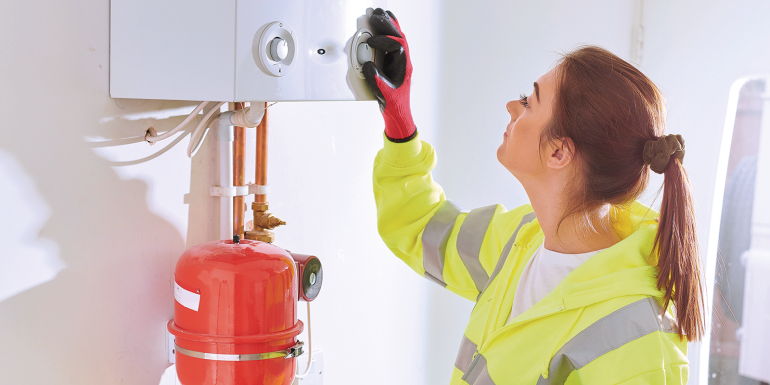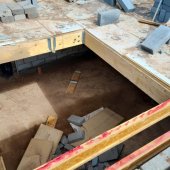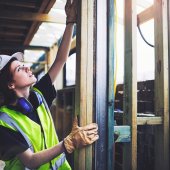Skills boost

Elmhurst Energy Managing Director Stuart Fairlie explains why going faster and further with retrofit training is vital to meet rising demand.
The UK’s old, leaky homes penalise two million people in fuel poverty the worst. Around 88% of these fuel-poor households live in a property of Energy Performance Certificate (EPC) band D or lower and bear the brunt of crippling fuel bills and the health impacts of cold, damp homes. These properties also contribute significantly to the carbon emissions from our building stock.
The roots of such poor housing can in part be explained by the age of British homes, owing to the fact older homes are less likely to be energy efficient, especially without repairs and improvement. More than half of our homes were built before 1965 and 20% before 1919. Our ageing housing stock has become a big challenge for people and the planet.
Despite recent U-turns on some parts of England’s energy efficiency policy, as a country we are still legally committed to reaching net zero by 2050. But to reach that target, it’s said that 1.5 homes need to be retrofitted every minute. This is a feat that requires a well-trained retrofit workforce in the hundreds of thousands.
To build that workforce, what is needed are clear and long-term energy efficiency commitments from policy-makers, backed by a national retrofit programme that offers specific targets and training routes.
This is a valuable market. The Construction Leadership Council has estimated in its blueprint for a national retrofit strategy that upgrading our national housing stock would create around 500,000 jobs, with £2 put back into the economy for every £1 invested. There is also a major opportunity to bring back into use some of the 676,000 homes currently sitting empty, which, according to House Buyer Bureau, are worth £212bn.
Groups like the National Retrofit Hub are progressing well with working out how best to enable faster delivery of retrofit across the UK. The Hub’s working group 3, on workforce growth and skills development, is undertaking research to map skills pathways and identify the gaps in skills and training. It has established a range of initiatives to start this autumn.
Despite all this opportunity, rates of retrofit still appear to be falling. According to the Mission Retrofit report from Mission Zero Coalition, a decade ago 2.3 million energy efficiency measures were installed annually through government-backed schemes. There were fewer than 100,000 in 2021 and 204,100 in 2022. These included just 32,000 cavity wall retrofits, 24,000 loft insulations and 10,000 solid wall insulations.
Schemes in progress
To tackle all of this, we must go further and faster with retrofit training to bring British housing up to scratch. And there are pockets of funding designed to create a 260,000 workforce of retrofit designers, co-ordinators, assessors and installers.
Along with 17 other providers, Elmhurst will now deliver retrofit skills training in wave two of the government’s Home Decarbonisation Skills Training (HDST) competition. Both waves are delivering more than £18m of free or heavily subsidised training. Elmhurst’s courses include domestic energy assessor (DEA) and retrofit assessor training for new entrants, retrofit assessor upskilling for DEAs, and a new qualification course extending the competency of retrofit assessors to cover energy efficiency for older and traditional buildings. The funding adds a significant chunk of capacity, while training will also support delivery to vital PAS 2035 whole house retrofit standards (see PAS 2025).
There is also a clear intent to scale up heat pump deployment to 600,000 installations a year by 2028, met by significant private sector training investments from the likes of Octopus Energy and Ideal Heating, with funding support from the government.
Older building? Quality matters
Of course, it is not solely a training volume issue. A ramped-up retrofit training effort will have to account for the complexities of the process involved in deep retrofit of older homes, along with high-quality installation of energy efficiency measures.
Installation quality is a major factor in improving housing standards. Done right, it avoids any adverse effects associated with improper fitting or poor product choice – and, in some cases, the counterproductivity of single-measure, piecemeal energy efficiency measures.
The vast array of traditional dwellings in Britain, ranging from Victorian or Georgian terraces to timber-framed Tudor properties and 1930s detached pre-war homes, calls for a higher level of retrofit knowledge and skill.
Elmhurst’s new Energy Efficiency for Older and Traditional Buildings, available through HDST wave two, addresses the complexities. Thermal performance, heating and ventilation, as well as building defects and damp, mould and condensation that can arise from poor retrofit, are considered in detail. It supports a greater understanding of BS 7913 – the standard of good practice for works to older, traditional buildings – while exploring the impact of occupant behaviour and local and regional variations in building methods, materials and styles across the UK.
Retrofit training is about to experience a growth period that is increasingly accounting for the nuances in UK housing. Rapidly growing our retrofit workforce and related supply chains is crucial if we are to begin reversing the housing standards crisis while delivering green economic and societal benefits we cannot afford to ignore.

PAS 2035
PAS 2035 was one of the most important products of the Each Home Counts review. It sets out the framework to follow for an effective whole house or whole building approach to retrofit.
The latest version of PAS 2035 (2023) has been published, featuring a number of important updates for retrofit professionals across the UK. This release follows the British Standards Institution’s public consultation on PAS 2035 earlier this year and aims to enhance the retrofit process. At the time of writing, the transition to the new PAS 2035 has not been finalised. But some of the main changes on the way will enhance the retrofit process and include:
- updated criteria for retrofit assessor, retrofit co-ordinator and retrofit designer roles
- removal of the Risk Path procedure
- a required medium-term improvement plan for all properties
- updated and expanded Traditional Construction definition
- updated design criteria for the leakage and airtightness strategy; and
- retrofit co-ordinators to collect evidence showing correct installation of energy efficiency measures.
For more, visit elmhurstenergy.co.uk










